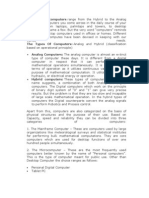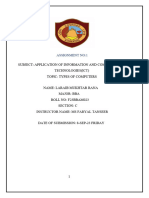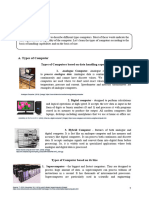0% found this document useful (0 votes)
83 views4 pagesWeek 3 - Desktop Computers
The document discusses different types of computers including personal computers, laptops, tablets, smartphones, smartwatches, and mainframe computers. Personal computers, also known as desktop computers, were revolutionized in the 1980s and became small enough to fit on a desk and affordable for personal use. Personal computers can be used by a single user or networked with other computers and have advantages like standardized parts, better specifications, and cheaper costs compared to laptops.
Uploaded by
sahoopragyan2510Copyright
© © All Rights Reserved
We take content rights seriously. If you suspect this is your content, claim it here.
Available Formats
Download as PDF, TXT or read online on Scribd
0% found this document useful (0 votes)
83 views4 pagesWeek 3 - Desktop Computers
The document discusses different types of computers including personal computers, laptops, tablets, smartphones, smartwatches, and mainframe computers. Personal computers, also known as desktop computers, were revolutionized in the 1980s and became small enough to fit on a desk and affordable for personal use. Personal computers can be used by a single user or networked with other computers and have advantages like standardized parts, better specifications, and cheaper costs compared to laptops.
Uploaded by
sahoopragyan2510Copyright
© © All Rights Reserved
We take content rights seriously. If you suspect this is your content, claim it here.
Available Formats
Download as PDF, TXT or read online on Scribd
/ 4


























































